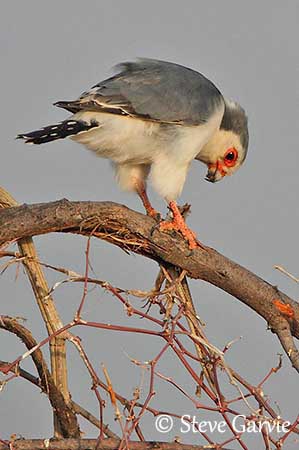
Fr: Fauconnet d’Afrique
All : Halsband-Zwergfalke
Esp : Halconcito Africano
Ital: Falco pigmeo africano
Nd: Afrikaanse Dwergvalk
Russe: Африканский малый сокол
Photographers:
Steve Garvie
RAINBIRDER Photo galleries & Flickr Rainbirder
Tom Merigan
Tom Merigan’s Photo Galleries
Callie de Wet
GALLERY
Sources:
HANDBOOK OF THE BIRDS OF THE WORLD Vol 2 by Josep del Hoyo-Andrew Elliot-Jordi Sargatal - Lynx Edicions - ISBN: 8487334156
BIRDS OF PREY OF AFRICA AND ITS ISLANDS by Alan and Meg Kemp - Struik Publishers - ISBN: 1770073698
Animal Diversity Web (University of Michigan Museum of Zoology)
Wikipedia (Wikipedia, The Free Encyclopedia)
African Pygmy Falcon
Polihierax semitorquatus
Falconiforme Order – Falconidae Family
BIOMETRICS:
Length: 20cm
Wingspan: 37 cm
Weight: 54-67 g
DESCRIPTION:
African Pygmy Falcon is the smallest falcon of the African continent.
Adult male has pale grey upperparts with narrow white collar and white rump. Flight feathers and rectrices are black, finely spotted and tipped white.
Underparts are white. Undertail feathers are barred black and white.
On the head, forehead, crown and nape are grey, extending into a point to the neck sides. Face shows white eyebrow and cheeks. Cere, lores and eye-rings are red-orange.
The hooked bill is grey with black tip. Eyes are dark brown. Legs and feet are red-orange.
Female is similar, but she has deep chestnut mantle.

Male
East African population
Juvenile resembles adult of the same sex. Upperparts are grey with buff-tipped feathers in young male. Underparts are slightly washed rufous.
In young female, upperparts are dull chestnut on back, with buff-tipped feathers and buffy tinge on underparts.
Both have paler orange bare parts than adults.
VOICE: SOUNDS BY XENO-CANTO
African Pygmy Falcon is noisy during the breeding season, uttering high-pitched calls and songs “twee-twee-twip” or “kiki-kik” used by the male. It also gives thin, squeaky “tsip-tsip”. Calls are often high-pitched.
The young give sharp “ki-ki-ki-ki-ki-ki” when alarmed.
While uttering these sounds, the bird bobs the head and moves the tail up and down.

HABITAT:
African Pygmy Falcon frequents arid and semi-arid steppes with sparse vegetation and some large trees or plants.
It uses the weaver nests as roost, but also as nest-site, and especially the huge communal nesting structure of Sociable Weaver (Philetairus socius) in South Africa.
They often roost in pairs or family groups in the same nest-chamber or adjacent ones. It also may use other weaver or starling nests.
RANGE:
African Pygmy Falcon has two populations in Africa. One in SW Africa is associated with the Sociable Weaver, and the second in E Africa, associated with the White-headed Buffalo Weaver (Dinemellia dinemelli).
BEHAVIOUR:
African Pygmy Falcon feeds mainly on small lizards and large insects. It also takes some rodents and birds.
It hunts from perch, swooping down onto the prey on the ground. It may perform short aerial chases, but rarely.
When roosting in the weaver colonies, it may catch sometimes adult weavers and nestlings.
African Pygmy Falcon is often seen perched on exposed perches, twigs and branches, watching for preys. It is usually alone, in pairs or in family groups.

During the breeding season, the African Pygmy Falcon performs some courtship displays such as bobbing the head, bowing and wagging the tail, accompanied by calls.
This tiny falcon invariably occupies part of the huge communal nesting structures of Sociable weavers. In some regions, such as the Kalahari, several Pygmy Falcons are resident in these nests.
African Pygmy Falcon is usually resident in most part of the range. They may perform local movements during the period of great aridity in the driest areas.
During winter, it remains confined to the nest-chamber for up to 15 hours per day.
FLIGHT:
African Pygmy Falcon performs undulating flight with bursts of fast wing-beats interspersed with dip and glides, as woodpeckers do.
REPRODUCTION:
Breeding season occurs between June and December in NE Africa and between August and March in South Africa.
African Pygmy Falcon is usually monogamous during one season, but it may be occasionally polyandrous, with two males or more attending the same nest. This behaviour is mainly observed when the nest-site availability is reduced.
The pair occupies a nest-chamber in the weaver communal nest. The nest entrance becomes coated with the droppings of the falcons.

Female lays 3 eggs. Incubation lasts about 28 days to one month, and both parents share it, but female incubates more than male which brings food to her while she is on the nest.
Chicks are covered in white down. The male hunts and brings preys to the female, and she feeds and tends the chicks. They fledge about 27 to 40 days after hatching, but they remain in the parental territory for up to two months after leaving the nest.
This species may produce two broods per season, but usually only one. Parents defend the nest and are very aggressive towards intruders if they approach the nest.



Female
East African population

